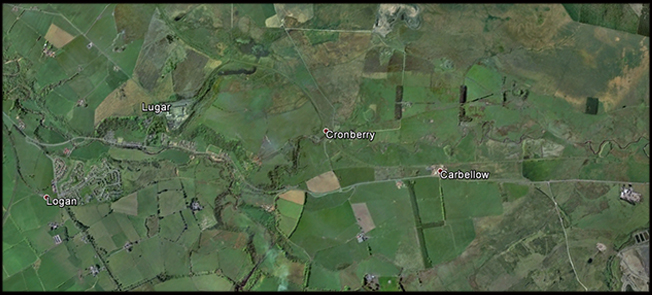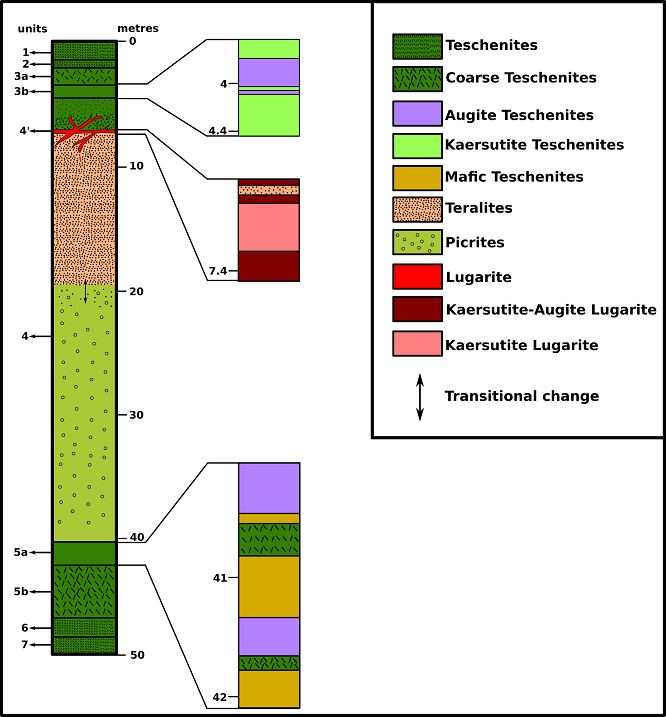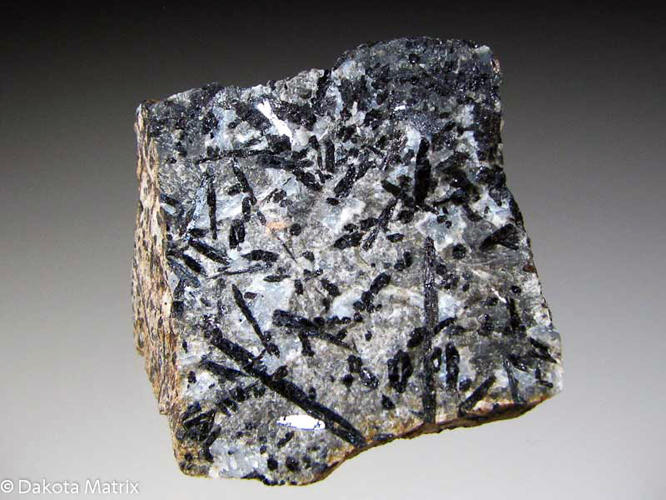Lugarite
Lugarite: A coarse-grained rock consisting of euhedral crystals of titanaugite and kaersutite up to 7cm long with, corroded feldspars and ilmenite, set in a cloudy greyish base of analcime, nepheline and alteration products. (Tyrell, 1917)Lugar Sill
The Lugar Sill intrusion (Fig.1-2) occurs near the village of Lugar in Central Ayrshire. It is intruded as a sill into a white and yellow sandstone. the thickness of the igneous rock is estimated at 42-49 m. Apart from small irregularities the outcrop forms a crescent-shaped strip about 4.5-5 km long and 3-400 m wide at its widest part. It extends in a general north-easterly direction from Lugar, 2.5 Km beyond the village of Cronberry. The lugar Sill is a picrite-teschenite-theralite sill: Teschenites are sub-volcanic basic rocks wihth plagioclase feldspar, analcime, and titaniferous augite, with kaersutite, nepheline, and olivine usually in lesser amounts); Theralites are calcic foidal gabbro.
Fig.1: Google Earth picture of Lugar area.
.jpg)
Fig.2: Outcrop of the Lugar sill (red). Modified by Henderson (1987).
The Lugar sill became established in the petrological literature as a classic example of a differentiated alkaline basic/ultrabasic sill due mainly to the pioneering work of Tyrrell (1917, 1948, 1952). In a recent reinvestigation of this sill (Henderson and Gibb, 1987), material from a new, continuous 42 m drill core through the sill has been used to subdivide it into nine units (Fig.3):

Fig.3: Petrographic subdivision of the Lugar Sill. Modified by Henderson and Gibb, 1987.
• Upper marginal teschenite (unit 1)
Grain-size increases away from the upper chilled contact of the sill. The olivine teschenite is extensively altered, especially near the contact, but about 1,4 m below the top the rock consists of plagioclase laths up to 3 mm long, subhedral crystals of brownish Augite 1 to 2 mm across, in a highly altered, brownish, fine-grained matrix of nepheline, analcime, chlorite, sericite, apatite, biotite and probably alkali feldspar.
• Upper teschenite (unit 2)
At the bottom of unit 1 there is a sharp contact between the olivine teschenite and a much finer-grained teschenite which coarsens downwards. As it coarsens it becomes identical to the teschenite of unit 1 except for irregular, interstitial areas a millimeter or two across of clear analcime.
• Upper coarse teschenite (unit 3a)
At the top of this unit the rock consists of subhedral augites and kaersutites, particularly abundant Fe-Ti oxides, altered plagioclase and biotite, in an even finer-grained matrix. As it coarsens downwards the amounts of kaersutite an d Fe- Ti oxide decrease and green pseudomorphs after olivine become more abundant. The bottom of this unit is characterized by a particularly high content of euhedral augites elongated with a sub-horizontal fabric; this rock could be a basal cumulate of the overlying coarse teschenite.
• Upper layered mafic teschenite (unit 3b)
The coarse, pyroxene-rich rock at the base of unit 3a gives way abruptly to a finer-grained type rich in olivine pseudomorphs. This change marks the top of a complex unit characterized by higher contents of mafic minerals than the teschenites above. The top of this unit consists of abundant olivine pseudomorphs and a few equant subhedral augite crystals (both up to1 mm across) in a highly altered matrix dominated by small anhedral augites. The size and amount of the larger augites increases downwards a t the expense of the small groundmass pyroxenes, and kaersutite and biotite become more common. Although the kaersutite is not quite as abundant as in the kaersutite picroteschenite at the bottom of the unit.
• Theralite-kaersutite theralite-picrite (unit 4)
At a depth of 4,45 m the medium-grained picroteschenite at the bottom of unit 3b gives way suddenly to very fine-grained theralite. This marks the top of the 35,5 m thick main central unit of the sill.
The kaersutite theralite persists to about 20 m with a downwards increase in olivine content and variations in the degree of alteration. As olivine becomes more abundant, the crystals of kaersutite become fewer but larger and poikilitically enclose the olivines. Between 18 m and 20 m, the augites gradually change from the tiny grains characteristic of the theralites to subhedral, equant crystals up to 1,5 mm across. This easily detectable change marks the transition from kaersutite theralite to picrite. Towards the top of the picrite, the rock consists of abundant crystals of olivine and augite, both up to 1,5 mm across.
• Lugarite Horizons (unit 4')
Tyrrell (1917) defined lugarite as a coarse-grained rock consisting of euhedral crystals of titanaugite and barkevikite (now kaersutite) up to 7cm long with corroded feldspars and ilmenite set in a cloudy greyish base of analcime, nepheline and alteration products. However, he recognized that some varieties contain only kaersutite or augite while others contain both: kaersutite lugarite, augite lugarite and normal or kaersutite augite lugarite, respectively.
• Lower layered mafic teschenite (unit 5a)
Between 40 m and 42 m is a complex unit in which different varieties of mafic teschenite are interlayered with coarse teschenite.
• Lower coarse teschenite (unit 5b)
This unit consists of coarse teschenite like that of unit 3a, with characteristic large subhedral prisms of augite having a ragged appearance and coarse plagioclase laths. This coarse teschenite is more altered than its upper counterpart and becomes more so downwards such that by 45 m only ghosts of the original large augites and plagioclase laths are visible.
• Lower teschenite (unit 6) and Lower marginal teschenite (unit 7)
From about half way down unit 5b to the bottom of the sill the rock is almost completely altered and carbonated, but grain size variations in the drill cores reveal downward chilling effects which define the two lowermost teschenite units.
Petrogenesis and Source of the magmas
The age of emplacement of the sill has been shown to be on or close to the Carboniferous- Permian boundary (Henderson et al. 1987) and the sill clearly consists of two consecutively intruded parts:• Teschenitic part
An outer, first-intruded teschenitic part was emplaced in a series of pulses to form: a) marginal teschenites (units 1 and 7); b) teschenites (units 2 and 6); c) coarse teschenites (units 3a and 5b); d) layered mafic teschenites (units 3b and 5a). These units are symmetrically arranged in the upper and lower parts of the sill and usually show chilled margins.
the total thickness of the upper and lower teschenitic units varies from about 10m to 16 m. The mineral composition trends and rock major and trace element analytical data show that the first magma pulse was the most differentiated with the degree of evolution decreasing progressively from (a) to (d).
The layering in units (3b and 5a) may partly reflect emplacement of heterogeneous material (relatively olivine-rich alternating with olivine-poor) and partly in situ differentiation. The enrichment of kaersutite in the upper layered mafic teschenite rather than augite as in the equivalent lower unit, may be the result of upward enrichment of volatile phases during differentiation of the teschenitic proto-sill.
• Theralite-Picrite unit
Shortly after the emplacement of the teschenitic proto-sill, magma was intruded to form the main, olivine-rich central unit. The fine-grained theralite at the top of the central unit is believed to represent an upper chilled margin.
Following intrusion at a depth of 1km (300 bars) the magma differentiated in situ. The in situ magmatic differentiation was accompanied by the upward enrichment of incompatible elements (e.g. Zr, Sr, Rb) as evidenced by the higher concentrations in kaersutite theralites compared to picrites having similar MgO contents. This enrichment could be due to the upward displacement of residual liquid and, or the volatile phase. The lugarite magma presumably formed at this stage within the upper regions of the kaersutite theralite.
Henderson and Gibb (1987) agree with Tyrrell (1917, 1948, 1952) to the extent that the various differentiated magmas that filled the Lugar Sill came from a common parent that had itself differentiated in a lower-level magma chamber, perhaps with further modification during the intrusion process. The next stage in the magmatic development involved differentiated magmas being ejected from the chamber, from the top down, perhaps in a series of pulses. Thus the most fractionated liquids were the first to be intruded into the Lugar Sill.
It seems likely that some pulses of teschenitic magma also carried previously crystallized olivine and augite. This could be controlled by the rate of magma extraction from the lower level camber. As the chamber was progressively emptied, theralitic liquid containing olivine phenocrysts was sampled. As more olivine accumulate was scoured-out, the later intruded material became increasingly olivine-rich.
However, it is possible that flow-differentiation within the conduit leading from the magma chamber to the Lugar Sill could also have influenced the distribution of olivine in the rising theralitic liquid
.jpg)
Lugarite sample. Note the big kaersutite crystals. From Dakota matrix minerals

Lugarite sample. Note the big kaersutite crystals. From Dakota matrix minerals
Sample kindly given to me by Robert Gill.
Bibliography
• C.M.B. Henderson and F.G.F. Gibb (1987): The petrology of the Lugar Sill, SW Scotland. Transactions of the Royal Society of Edinburgh: Earth Sciences, 77 (for 1986}, 325-347, 1987
• C.M.B. Henderson, F.G.F. Gibb, K.A. Foland (1987): The age of the Lugar sill and a discussion of the Late-Carboniferous/Early-Permian sill complex of S.W. Scotland. Geological Journal Volume 22, Issue 1, pages 43–52
• Tyrell. G (1917): The Picrite-Teschenite Sill of Lugar.Quart. Journ. Geological Soc. Vol. 72, Part 2.


.jpg)
.jpg)
.jpg)
.jpg)
.jpg)
.jpg)
.jpg)
.jpg)
.jpg)
.jpg)
.jpg)
.jpg)
.jpg)
.jpg)
.jpg)
.jpg)
.jpg)
.jpg)
.jpg)
.jpg)
.jpg)
.jpg)
.jpg)
.jpg)
.jpg)
.jpg)
.jpg)
.jpg)
.jpg)
.jpg)
.jpg)
.jpg)
.jpg)
.jpg)
.jpg)
.jpg)
.jpg)
.jpg)
.jpg)
.jpg)
.jpg)
.jpg)
.jpg)
.jpg)
.jpg)
.jpg)
.jpg)
.jpg)
.jpg)
.jpg)
.jpg)
.jpg)
.jpg)
.jpg)
.jpg)
.jpg)
.jpg)
.jpg)
.jpg)